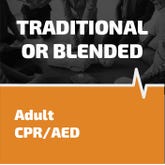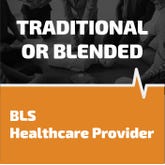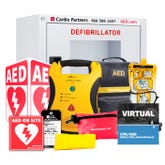5 Things You Need to Do After a Heart Attack or Cardiac Arrest
- Feb 19, 2018

Tips for Maintaining Whole-Body Wellness After Heart Attack or Sudden Cardiac Arrest
Regular readers of this blog know that heart attacks and cardiac arrest are not the same; however, some may be surprised to learn that a heart attack may lead to sudden cardiac arrest (SCA.) In what seems like a cruel twist of fate, it’s not at all uncommon for SCA to follow a heart attack. The greatest risk of a post-heart attack SCA is during the first 30 days after a heart attack (Duke Clinical Research Institute). Take heart: in this post, we’ll share a few tips and resources so that you can get back to living your best life and reduce the risk of post heart attack cardiac arrest.
Find a Support Network
If you’re feeling worried and anxious after your cardiac event, take comfort in knowing that you’re not alone. Many heart attack and sudden cardiac arrest survivors experience a host of emotions ranging from joyful gratitude to fear and trepidation. Life after a heart attack or SCA can be overwhelming, and for some may even feel uncertain.
It’s very common for heart attack and SCA survivors to experience anger, depression, denial, and anxiety. These feelings typically last for two to six months,and it’s important to recognize them and deal with them by seeking help. Your doctor should be able to recommend a mental health specialist who specializes in cardiac recovery. Let your loved ones know how you’re feeling, too. They can’t fully support you if they don’t know how you’re feeling.
For the first few weeks, it may be comforting to have someone nearby to help and support you. If you don’t have friends or loved ones who can stay with you, ask your care team to recommend resources near you. In the meantime, here are a few online resources to get you started:
Set Goals for Healthy Living
To minimize the risk of SCA or of having another heart attack — and to maximize your chances for a full recovery — it’s critically important to begin a regular fitness and activity routine as soon as possible. Be sure to consult with your physician before starting an exercise regime!
A few months ago we wrote a blog entitled 5 Strategies to Prevent Heart Disease, and while the strategies covered in the post are great for preventing a heart attack, they apply equally well to life after a cardiac event:
-
Eat a diet low in animal proteins, high in fiber, and rich with fruits vegetables.
-
If you’re overweight or obese, make a commitment to lose weight.
-
If you smoke, stop.
-
Develop a physician-approved exercise program.
-
Get plenty of rest.
-
“A healthy diet is one of the best weapons you have to fight cardiovascular disease. The food you eat (and the amount) can affect other controllable risk factors: cholesterol, blood pressure, diabetes and overweight. Choose nutrient-rich foods — which have vitamins, minerals, fiber and other nutrients but are lower in calories — over nutrient-poor foods. Choose a diet that emphasizes intake of vegetables, fruits, and whole grains; includes low-fat dairy products, poultry, fish, legumes, nontropical vegetable oils, and nuts; and limits intake of sweets, sugar-sweetened beverages, and red meats” (American Heart Association).
-
Find a Cardiac Rehabilitation Program
-
The Cleveland Clinic writes, “Patients who join cardiac rehabilitation programs have a faster and safer recovery and better outcomes after a heart attack. It is important to follow your cardiac rehabilitation team’s instructions for activity. Everyone recovers at a different pace. This may be related to your activity level before your heart attack or the amount of damage to your heart muscle. It may take many months to develop the optimal exercise program.”
-
By joining an outpatient cardiac rehabilitation program, not only are you committing to your recovery and living a full life after your cardiac event, but you’ll be doing so with a community of survivors. Many rehab programs are covered by insurance.
-
Take it Slow
-
Remember, recovery’s not a race! Your heart, mind, and body will need time to heal. Start by walking and slowly and gradually increase your pace. You should have slightly increased breathing, but you should be able to carry on a conversation. If you’re short of breath, slow down! If you’re walking outside, walk with a partner and stick close to home.
-
Once you’ve build your resilience back up by walking, choose an activity that you enjoy such as biking, swimming, or water aerobics and work it into your daily routine. Of course, if you are experiencing excessive shortness of breath, chest pains, heart palpitations, dizziness, or chronic fatigue, stop exercising and call your doctor!
-
Invest in an AED
-
You’re a survivor, invest in your future. Contact AED.com at 800-544-0004 to learn more about new or recertified AEDs for home use. We also welcome your emails; you can reach us at customerservice@cardiopartners.com.









 CALL US:
CALL US: